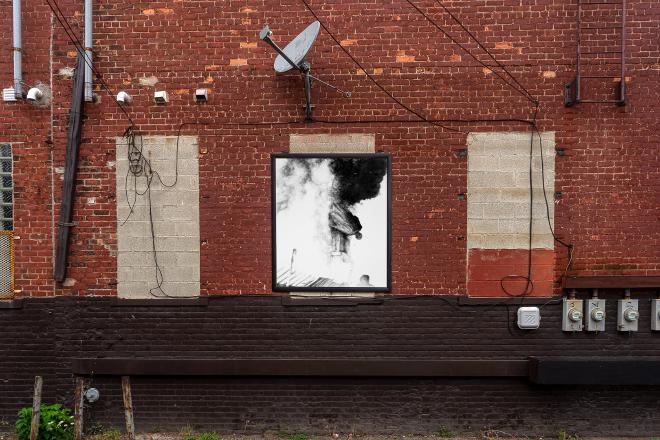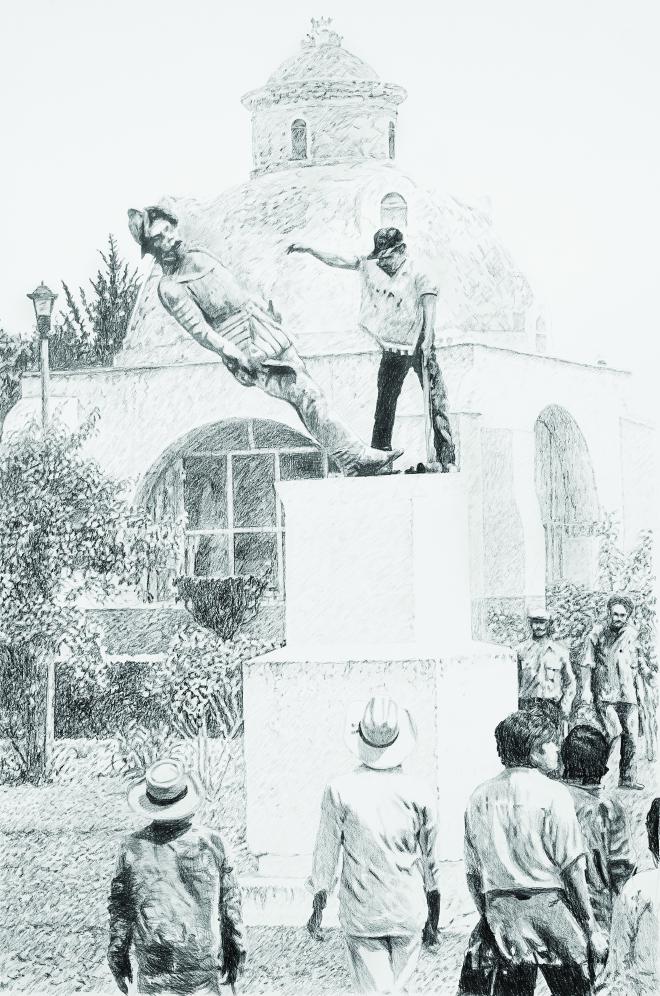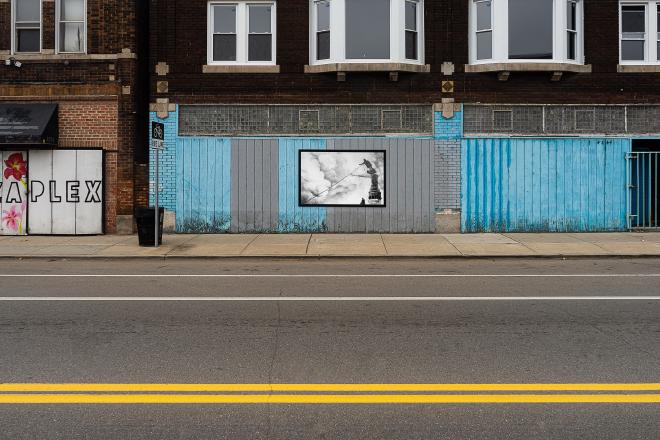- / Work/
Iconoclasm
On this page
Images #

Graphite on paper
66″ × 56″
Drawing in collaboration with Milenko Prvački
Photo credit: Makenzie Goodman

Graphite on paper
66″ × 56″
Drawing in collaboration with Milenko Prvački
Presented in partnership with University of Michigan Dearborn - Mardigian Library
Photo credit: Darryl Deangelo Terrell

Graphite on paper
67″ × 58″
Drawing in collaboration with Sam George
Photo credit: Makenzie Goodman

Graphite on paper
67″ × 58″
Drawing in collaboration with Sam George
Presented in Hamtramck, MI
Photo credit: Darryl Deangelo Terrell

Graphite on paper
48.5″ × 63.5″
Drawing in collaboration with Milenko Prvački
Photo credit: Makenzie Goodman

Graphite on paper
48.5″ × 63.5″
Drawing in collaboration with Milenko Prvački
Presented in Highland Park, MI
Photo credit: Darryl Deangelo Terrell

Graphite on paper
47″ × 69″
Drawing in collaboration with Milenko Prvački
Photo credit: Makenzie Goodman

Graphite on paper
47″ × 69″
Drawing in collaboration with Milenko Prvački
Presented in partnership with the Hellenic Museum of Michigan
Photo credit: Darryl Deangelo Terrell

Graphite on paper
67″ × 56″
Drawing in collaboration with Milenko Prvački
Photo credit: Makenzie Goodman

Graphite on paper
67h″ × 56″
Drawing in collaboration with Milenko Prvački
Presented in partnership with Cranbrook Art Museum
Photo credit: Darryl Deangelo Terrell

Graphite on paper
72″ × 47″
Drawing in collaboration with Milenko Prvački
Photo credit: Makenzie Goodman

Graphite on paper
72″ × 47″
Drawing in collaboration with Milenko Prvački
Presented in Cass Corridor, Detroit, MI - Stolen
Photo credit: Darryl Deangelo Terrell

Graphite on paper
53.5″ × 84″
Drawing in collaboration with Sam George
Photo credit: Makenzie Goodman

Graphite on paper
53.5″ × 84″
Drawing in collaboration with Sam George
Presented in Southwest, Detroit, MI
Photo credit: Darryl Deangelo Terrell

Graphite on paper
48″ × 61.5″
Drawing in collaboration with Milenko Prvački
Photo credit: Makenzie Goodman

Graphite on paper
48″ × 61.5″
Drawing in collaboration with Milenko Prvački
Presented in East Village Detroit, MI
Photo credit: Darryl Deangelo Terrell

2018
Graphite on paper
53.5″ × 82″
Drawing in collaboration with Sam George
Photo credit: Makenzie Goodman

2018
Graphite on paper
59.5″ × 53″
Drawing in collaboration with Sam George
Photo credit: Makenzie Goodman

2018
Graphite on paper
50″ × 81″
Drawing in collaboration with Milenko Prvački
Photo credit: Makenzie Goodman

2018
Graphite on paper
50″ × 81″
Drawing in collaboration with Sam George
Photo credit: Makenzie Goodman

2018
Graphite on paper
55″ × 71″
Drawing in collaboration with Sam George
Photo credit: Makenzie Goodman

2018
Graphite on paper
57″ × 75″
Drawing in collaboration with Milenko Prvački
Photo credit: Makenzie Goodman

1265 Parkview St., Detroit, MI
Photo credit: Clare Gatto

1265 Parkview St., Detroit, MI
Photo credit: Clare Gatto

1265 Parkview St., Detroit, MI
Photo credit: Clare Gatto

1265 Parkview St., Detroit, MI
Photo credit: Clare Gatto

1265 Parkview St., Detroit, MI
Photo credit: Clare Gatto
Text #
The exhibition Iconoclasm presents a series of large-scale graphite drawings, which depict some of the most dramatic examples of iconoclastic destruction. The attacks on statues document a range of archival sources such as photography, newspaper and televised imagery, illustrating a broad historical and transnational arc. The drawings highlight the long history and international scope of image breaking and feature significant examples of religious, cultural and political destruction. Examples include religiously motivated acts from sixteenth century European Protestant destruction to contemporary Islamic fundamentalism, in addition to politically and culturally motivated acts, such as the 1871 toppling of the Column Vendome in Paris, in which artist Gustav Courbet participated, and against communist statues in Europe and Africa; the cultural revolution in China; removals of colonial statues in the Carribbean, Central and South America; and nationalist uprisings of 1956 in Hungary and Egypt, among others.
As a means to bring together a diverse segment of the population to experience and discuss how communities relate to art and symbols in public space, Durant worked closely with Library Street Collective to establish community partners and place a selection of drawings in key locations throughout Metro Detroit. This presentation in public space allows vulnerability of the works and the possibility of interference in ways rarely seen in contemporary art today. The use of drawing reflects upon the ephemeral nature of art and challenges the indelible perception of historical events. The works exhibited in the gallery space carry the potential for registered markings of dialogue with the community through engagement and physical interventions upon the artworks.
Durant’s drawings are a reminder of the notion of a living history, reflecting humanity’s need to celebrate and commemorate, as well as the compulsion to destroy symbols of a past that conflict with a specific dominant world view. Given the global current rise in political polarization, religious extremism and nationalism, this work presents a critical opportunity to explore humanity’s relationship with the symbols of the past and how to address them as society changes.